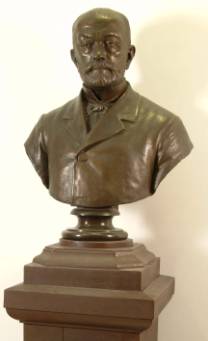Felice Giordano
Felice Giordano (1825-1892)

1825
Born in Turin, he studied in Savona.
1847
He graduated in Hydraulic Engineering and Civil Architecture in Turin.
The Minister for Home Affairs of the Savoy Kingdom, L. Des Ambrois, invited him and Q. Sella to specialize their studies at the École des Mines of Paris as officers of the R. Corpo delle Miniere.
1848
He returned to Italy to participate in the revolution.
1851
He left the École des Mines of Paris without having obtained a certificate. He travelled through Europe with Q. Sella, visiting the main mineral and metal centres in France, Belgium, Britain and Germany, coming into contact with foreign industrialists and scientists.
He visited the Universal Exhibition of Paris with Q. Sella.
1852
He was appointed 2nd Class Engineer at the R. Corpo delle Miniere and was sent to Cagliari, where he planned and realized the first Italian artificial lake (Sette Fratelli Mountains).
During his seven years of activities in Sardinia he contributed to reorganizing and revitalizing the mineral industry of the island, which had flourished even due to the growing introduction of foreign capital.
1856
He was appointed 1st Class Engineer at the R. Corpo delle Miniere.
1859
He was appointed Inspector of the R. Corpo delle Miniere in Turin, 1st Class Chief Engineer and member of the Mine Council.
He drew up the new Mine Acts of Turin, in collaboration with Q. Sella. The Acts later became Law no. 3755 dated 20 November 1859, which was then considered very advanced.
He became a member of the Governing Council of Agriculture of the Ministry of Trade and Industry; member of the Industrial Enquiries Committee and member of the International Monetary Commission.
1860
He travelled to Sicily to verify extraction activity conditions, particularly in the sulphur mines controlled by the mafia.
1862
He became 2nd Class Chief Inspector of the R. Corpo delle Miniere.
1863
He founded the Italian Alpine Club together with Sella, Barracco and Saint Robert.
1864
He carried out important studies on the iron industry in Italy for the Ministry of the Navy.
He drew up a technical report on temperatures in the Frejus tunnel and a preventive geological study on the S. Gottardo tunnel.
1865
The whole Public Administration was transferred from Turin to Florence.
1866
Among the most distinguished Italian Alpinists, he was the first to climb the Mount Cervino from the Italian side.
1867
He was in charge of the Italian section of the International Exhibition of Paris.
He flew with Simonin on the hot air balloon.
1870
He was appointed 1st Class Chief Inspector of the R. Corpo delle Miniere.
He prepared various technical reports for the Government: a hydro-geological study on the Roman countryside; a study on the physical-economic conditions of Rome for the transformation of the city’s building system and the law bill on the reclamation of the Agro Pontino area.
He was a member of various commissions: for the development of forest laws; the reconstruction of Casamicciola after the earthquake in 1883 and for the development of adequate aseismic regulations.
1871
The Public Administration was transferred from Florence to Rome.
1872
He was appointed by the Government to circumnavigate the globe in 4 years, looking for colonies to be acquired. He visited: India, Tibet, China, Japan, Australia, New Zealand and the Americas. He prepared various technical reports for the Ministry of Agriculture, Industry and Trade.
1873
The Government established the Geological Service as a section of the R. Corpo delle Miniere.
1876
He was appointed to restructure the Geological Service, the body in charge of preparing and realizing the Geological Map of Italy.
He prepared technical reports and studies on railway tracks, torrent layouts and exploration of drinking and irrigation waters.
1877-82
He started works for the Geological Map of Sicily, which was published in 1886 also on a large-scale.
from 1878
He ordered the mapping of territories neighbouring the capital city, of the Apuan Alps and the Elba Island as well as the reconnaissance of Calabria and the Western Alps.
1881
He promoted the small Geological Map of Italy, published in 1889.
1884
His friend Q. Sella died, leaving an enormous void at the Geological Service.
1885
He was a member of the International Commission for the Geological Map of Europe at the International Geological Congress of Berlin.
1892
He died in Vallombrosa, in Tuscany, falling from an escarpment.
Chief Inspector of the R. Corpo delle Miniere, Father of the Geological Map of Italy, he was awarded many charges and honorary titles such as Gran Ufficiale della Corona d’Italia, Cavaliere dell’Ordine di SS. Maurizio e Lazzaro, Ufficiale della Legion d’Onore e dell’Istruzione Pubblica.
He was author of many monographs and technical-scientific reports of fundamental importance for the organizational, administrative and industrial development of the Kingdom of Italy. His tireless efforts are closely related to the activities of Quintino Sella.
